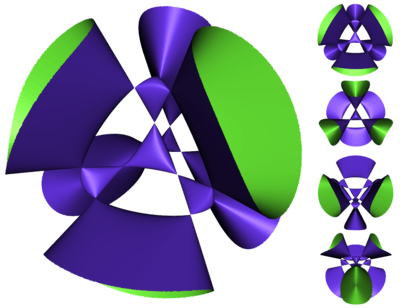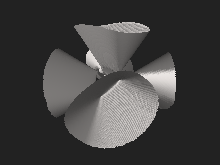Kummer surface
In algebraic geometry, a Kummer quartic surface, first studied by Kummer (1864), is an irreducible nodal surface of degree 4 in with the maximal possible number of 16 double points. Any such surface is the Kummer variety of the Jacobian variety of a smooth hyperelliptic curve of genus 2; i.e. a quotient of the Jacobian by the Kummer involution x ↦ −x. The Kummer involution has 16 fixed points: the 16 2-torsion point of the Jacobian, and they are the 16 singular points of the quartic surface. Resolving the 16 double points of the quotient of a (possibly nonalgebraic) torus by the Kummer involution gives a K3 surface with 16 disjoint rational curves; these K3 surfaces are also sometimes called Kummer surfaces.


Other surfaces closely related to Kummer surfaces include Weddle surfaces, wave surfaces, and tetrahedroids.
Geometry of the Kummer surface
Singular quartic surfaces and the double plane model
Let be a quartic surface with an ordinary double point p, near which K looks like a quadratic cone. Any projective line through p then meets K with multiplicity two at p, and will therefore meet the quartic K in just two other points. Identifying the lines in through the point p with , we get a double cover from the blow up of K at p to ; this double cover is given by sending q ≠ p ↦ , and any line in the tangent cone of p in K to itself. The ramification locus of the double cover is a plane curve C of degree 6, and all the nodes of K which are not p map to nodes of C.
By the genus degree formula, the maximal number possible number of nodes on a sextic curve is obtained when the curve is a union of lines, in which case we have 15 nodes. Hence the maximal number of nodes on a quartic is 16, and in this case they are all simple nodes (to show that is simple project from another node). A quartic which obtains these 16 nodes is called a Kummer Quartic, and we will concentrate on them below.
Since is a simple node, the tangent cone to this point is mapped to a conic under the double cover. This conic is in fact tangent to the six lines (w.o proof). Conversely, given a configuration of a conic and six lines which tangent to it in the plane, we may define the double cover of the plane ramified over the union of these 6 lines. This double cover may be mapped to , under a map which blows down the double cover of the special conic, and is an isomorphism elsewhere (w.o. proof).
The double plane and Kummer varieties of Jacobians
Starting from a smooth curve of genus 2, we may identify the Jacobian with under the map . We now observe two facts: Since is a hyperelliptic curve the map from the symmetric product to , defined by , is the blow down of the graph of the hyperelliptic involution to the canonical divisor class. Moreover, the canonical map is a double cover. Hence we get a double cover .
This double cover is the one which already appeared above: The 6 lines are the images of the odd symmetric theta divisors on , while the conic is the image of the blown-up 0. The conic is isomorphic to the canonical system via the isomorphism , and each of the six lines is naturally isomorphic to the dual canonical system via the identification of theta divisors and translates of the curve . There is a 1-1 correspondence between pairs of odd symmetric theta divisors and 2-torsion points on the Jacobian given by the fact that , where are Weierstrass points (which are the odd theta characteristics in this in genus 2). Hence the branch points of the canonical map appear on each of these copies of the canonical system as the intersection points of the lines and the tangency points of the lines and the conic.
Finally, since we know that every Kummer quartic is a Kummer variety of a Jacobian of a hyperelliptic curve, we show how to reconstruct Kummer quartic surface directly from the Jacobian of a genus 2 curve: The Jacobian of maps to the complete linear system (see the article on Abelian varieties). This map factors through the Kummer variety as a degree 4 map which has 16 nodes at the images of the 2-torsion points on .
The quadric line complex
Level 2 structure
Kummer's configuration
There are several crucial points which relate the geometric, algebraic, and combinatorial aspects of the configuration of the nodes of the kummer quartic:
- Any symmetric odd theta divisor on is given by the set points , where w is a Weierstrass point on . This theta divisor contains six 2-torsion points: such that is a Weierstrass point.
- Two odd theta divisors given by Weierstrass points intersect at and at .
- The translation of the Jacobian by a two torsion point is an isomorphism of the Jacobian as an algebraic surface, which maps the set of 2-torsion points to itself.
- In the complete linear system on , any odd theta divisor is mapped to a conic, which is the intersection of the Kummer quartic with a plane. Moreover, this complete linear system is invariant under shifts by 2-torsion points.
Hence we have a configuration of conics in ; where each contains 6 nodes, and such that the intersection of each two is along 2 nodes. This configuration is called the configuration or the Kummer configuration.
The Weil Pairing
The 2-torsion points on an Abelian variety admit a symplectic bilinear form called the Weil pairing. In the case of Jacobians of curves of genus two, every nontrivial 2-torsion point is uniquely expressed as a difference between two of the six Weierstrass points of the curve. The Weil pairing is given in this case by . One can recover a lot of the group theoretic invariants of the group via the geometry of the configuration.
Group theory, algebra and geometry
Below is a list of group theoretic invariants and their geometric incarnation in the 166 configuration.
- Polar lines
- Apolar complexes
- Klein configuration
- Fundamental quadrics
- Fundamental tetrahedra
- Rosenhain tetrads
References
- Barth, Wolf P.; Hulek, Klaus; Peters, Chris A.M.; Van de Ven, Antonius (2004), Compact Complex Surfaces, Ergebnisse der Mathematik und ihrer Grenzgebiete. 3. Folge., 4, Springer-Verlag, Berlin, doi:10.1007/978-3-642-57739-0, ISBN 978-3-540-00832-3, MR 2030225
- Dolgachev, Igor (2012), Classical algebraic geometry. A modern view, Cambridge University Press, ISBN 978-1-107-01765-8, MR 2964027
- Hudson, R. W. H. T. (1990), Kummer's quartic surface, Cambridge Mathematical Library, Cambridge University Press, ISBN 978-0-521-39790-2, MR 1097176
- Kummer, Ernst Eduard (1864), "Über die Flächen vierten Grades mit sechzehn singulären Punkten", Monatsberichte der Königlichen Preußischen Akademie der Wissenschaften zu Berlin: 246–260 Reprinted in (Kummer 1975)
- Kummer, Ernst Eduard (1975), Collected Papers: Volume 2: Function Theory, Geometry, and Miscellaneous, Berlin, New York: Springer-Verlag, ISBN 978-0-387-06836-7, MR 0465761
- Voitsekhovskii, M.I. (2001) [1994], "Kummer_surface", Encyclopedia of Mathematics, EMS Press
This article incorporates material from the Citizendium article "Kummer surface", which is licensed under the Creative Commons Attribution-ShareAlike 3.0 Unported License but not under the GFDL.